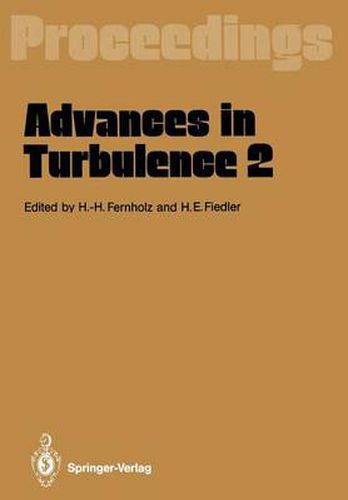Readings Newsletter
Become a Readings Member to make your shopping experience even easier.
Sign in or sign up for free!
You’re not far away from qualifying for FREE standard shipping within Australia
You’ve qualified for FREE standard shipping within Australia
The cart is loading…






This title is printed to order. This book may have been self-published. If so, we cannot guarantee the quality of the content. In the main most books will have gone through the editing process however some may not. We therefore suggest that you be aware of this before ordering this book. If in doubt check either the author or publisher’s details as we are unable to accept any returns unless they are faulty. Please contact us if you have any questions.
The Second European Turbulence Conference was held at the Technische Univer sitat Berlin, Federal Republic of Germany, from August 30th to September 2nd 1988 under the auspices of the European Mechanics Committee. It was primar ily devoted to fundamental aspects of turbulence, and aimed at bringing together engineers, physicists, and mathematicians. The scientific committee - serving also as Sub-committee of the European Turbulence Conference - consisted of the following members: G. Comte-Bellot (Lyon), H.-H. Fernholz and H.E. Fiedler (both from Berlin) as co-chairmen of the conference, U. Frisch (Nice), J.C.R. Hunt (Cambridge), E. Krause (Aachen), M. Landahl (Stockholm), A.M. Obukhov (Moscow), and G. Ooms (Amsterdam). The conference programme comprised 6 invited lectures and 94 contributions, presented either orally or at poster sessions. There were 165 participants from 18 countries. All papers published in these conference proceedings were, with the exception of the invited ones, again refereed by the members of the scientific committee. The main research topics discussed at this meeting were stability and gener ation of turbulence, effects of rotation, stratification and buoyancy forces, novel instrumentation, manipulation and control, boundary layers with separation and reattachment, computer simulation, turbulent diffusion, image analysis and flow visualization, vorticity dynamics and turbulence, and large-scale structures. We have taken the liberty of regrouping some papers following the submitted final versions for this volume. Authors may therefore find their paper under a different heading from that in the conference programme.
$9.00 standard shipping within Australia
FREE standard shipping within Australia for orders over $100.00
Express & International shipping calculated at checkout
This title is printed to order. This book may have been self-published. If so, we cannot guarantee the quality of the content. In the main most books will have gone through the editing process however some may not. We therefore suggest that you be aware of this before ordering this book. If in doubt check either the author or publisher’s details as we are unable to accept any returns unless they are faulty. Please contact us if you have any questions.
The Second European Turbulence Conference was held at the Technische Univer sitat Berlin, Federal Republic of Germany, from August 30th to September 2nd 1988 under the auspices of the European Mechanics Committee. It was primar ily devoted to fundamental aspects of turbulence, and aimed at bringing together engineers, physicists, and mathematicians. The scientific committee - serving also as Sub-committee of the European Turbulence Conference - consisted of the following members: G. Comte-Bellot (Lyon), H.-H. Fernholz and H.E. Fiedler (both from Berlin) as co-chairmen of the conference, U. Frisch (Nice), J.C.R. Hunt (Cambridge), E. Krause (Aachen), M. Landahl (Stockholm), A.M. Obukhov (Moscow), and G. Ooms (Amsterdam). The conference programme comprised 6 invited lectures and 94 contributions, presented either orally or at poster sessions. There were 165 participants from 18 countries. All papers published in these conference proceedings were, with the exception of the invited ones, again refereed by the members of the scientific committee. The main research topics discussed at this meeting were stability and gener ation of turbulence, effects of rotation, stratification and buoyancy forces, novel instrumentation, manipulation and control, boundary layers with separation and reattachment, computer simulation, turbulent diffusion, image analysis and flow visualization, vorticity dynamics and turbulence, and large-scale structures. We have taken the liberty of regrouping some papers following the submitted final versions for this volume. Authors may therefore find their paper under a different heading from that in the conference programme.